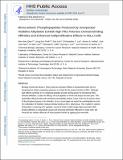| dc.contributor.author | Qian, Wen-Jian | |
| dc.contributor.author | Park, Jung-Eun | |
| dc.contributor.author | Lai, Christopher C. | |
| dc.contributor.author | Kelley, James A. | |
| dc.contributor.author | Park, Suk-Youl | |
| dc.contributor.author | Lee, Ki Won | |
| dc.contributor.author | Lee, Kyung S. | |
| dc.contributor.author | Burke, Terrence R. | |
| dc.contributor.author | Lim, Daniel Cham-Chin | |
| dc.contributor.author | Yaffe, Michael B | |
| dc.date.accessioned | 2016-12-19T15:36:20Z | |
| dc.date.available | 2016-12-19T15:36:20Z | |
| dc.date.issued | 2014-11 | |
| dc.date.submitted | 2014-09 | |
| dc.identifier.issn | 0006-3525 | |
| dc.identifier.issn | 1097-0282 | |
| dc.identifier.uri | http://hdl.handle.net/1721.1/105869 | |
| dc.description.abstract | Binding of polo-like kinase 1 (Plk1) polo-box domains (PBDs) to phosphothreonine (pThr)/phosphoserine (pSer)-containing sequences is critical for the proper function of Plk1. Although high-affinity synthetic pThr-containing peptides provide starting points for developing PBD-directed inhibitors, to date the efficacy of such peptides in whole cell assays has been poor. This potentially reflects limited cell membrane permeability arising, in part, from the di-anionic nature of the phosphoryl group or its mimetics. In our current article we report the unanticipated on-resin N(τ)-alkylation of histidine residues already bearing a N(π)- alkyl group. This resulted in cationic imidazolium-containing pThr peptides, several of which exhibit single-digit nanomolar PBD-binding affinities in extracellular assays and improved antimitotic efficacies in intact cells. We enhanced the cellular efficacies of these peptides further by applying bio-reversible pivaloyloxymethyl (POM) phosphoryl protection. New structural insights presented in our current study, including the potential utility of intramolecular charge masking, may be useful for the further development of PBD-binding peptides and peptide mimetics. | en_US |
| dc.description.sponsorship | National Institutes of Health (U.S.) (Grants ES015339 and GM104047) | en_US |
| dc.language.iso | en_US | |
| dc.publisher | Wiley Blackwell | en_US |
| dc.relation.isversionof | http://dx.doi.org/10.1002/bip.22569 | en_US |
| dc.rights | Creative Commons Attribution-Noncommercial-Share Alike | en_US |
| dc.rights.uri | http://creativecommons.org/licenses/by-nc-sa/4.0/ | en_US |
| dc.source | PMC | en_US |
| dc.title | Mono-anionic phosphopeptides produced by unexpected histidine alkylation exhibit high plk1 polo-box domain-binding affinities and enhanced antiproliferative effects in hela cells | en_US |
| dc.type | Article | en_US |
| dc.identifier.citation | Qian, Wen-Jian et al. “Mono-Anionic Phosphopeptides Produced by Unexpected Histidine Alkylation Exhibit High plk1 Polo-Box Domain-Binding Affinities and Enhanced Antiproliferative Effects in Hela Cells: Antiproliferative Effects in HeLa Cells.” Biopolymers 102.6 (2014): 444–455. | en_US |
| dc.contributor.department | Massachusetts Institute of Technology. Department of Biological Engineering | en_US |
| dc.contributor.department | Massachusetts Institute of Technology. Department of Biology | en_US |
| dc.contributor.department | Koch Institute for Integrative Cancer Research at MIT | en_US |
| dc.contributor.mitauthor | Lim, Daniel Cham-Chin | |
| dc.contributor.mitauthor | Yaffe, Michael B | |
| dc.relation.journal | Biopolymers | en_US |
| dc.eprint.version | Author's final manuscript | en_US |
| dc.type.uri | http://purl.org/eprint/type/JournalArticle | en_US |
| eprint.status | http://purl.org/eprint/status/PeerReviewed | en_US |
| dspace.orderedauthors | Qian, Wen-Jian; Park, Jung-Eun; Lim, Dan; Lai, Christopher C.; Kelley, James A.; Park, Suk-Youl; Lee, Ki Won; Yaffe, Michael B.; Lee, Kyung S.; Burke, Terrence R. | en_US |
| dspace.embargo.terms | N | en_US |
| dc.identifier.orcid | https://orcid.org/0000-0002-9547-3251 | |
| mit.license | OPEN_ACCESS_POLICY | en_US |
